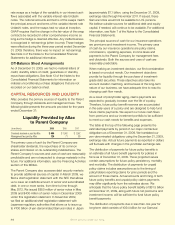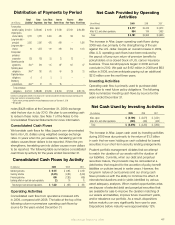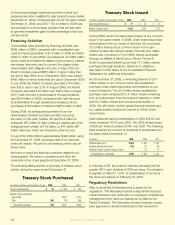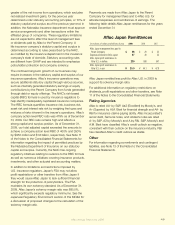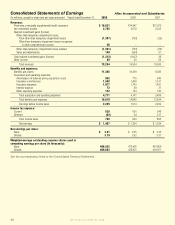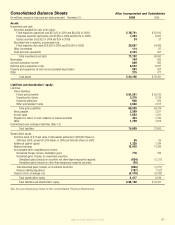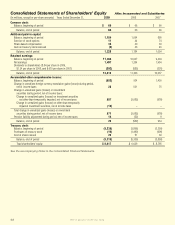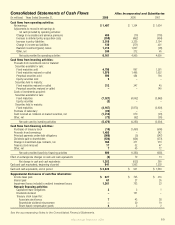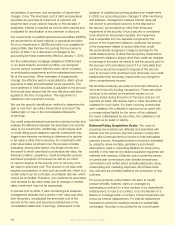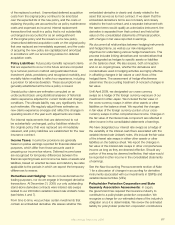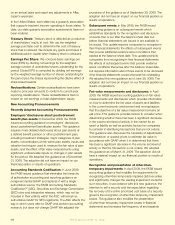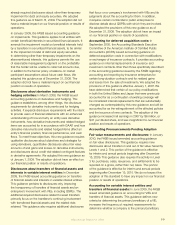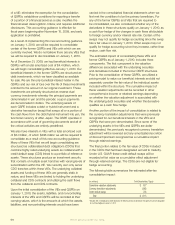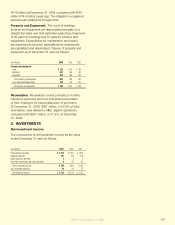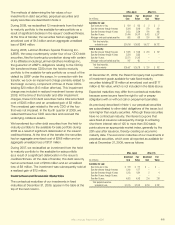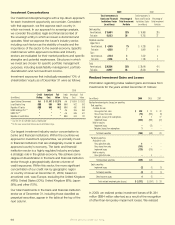Aflac 2009 Annual Report Download - page 60
Download and view the complete annual report
Please find page 60 of the 2009 Aflac annual report below. You can navigate through the pages in the report by either clicking on the pages listed below, or by using the keyword search tool below to find specific information within the annual report.
amortization of premium, and recognition of impairment
charges, if any. The amortized cost of debt and perpetual
securities we purchase at a discount or premium will
equal the face or par value at maturity or the call date, if
applicable. Interest is reported as income when earned and
is adjusted for amortization of any premium or discount.
Our investments in qualied special purpose entities (QSPEs)
are accounted for as xed-maturity or perpetual securities.
All of our investments in QSPEs are held in our available-for-
sale portfolio. See the New Accounting Pronouncements
section of Note 1 for a discussion of changes to the
accounting for these investments effective January 1, 2010.
For the collateralized mortgage obligations (CMOs) held
in our xed-maturity securities portfolio, we recognize
income using a constant effective yield, which is based
on anticipated prepayments and the estimated economic
life of the securities. When estimates of prepayments
change, the effective yield is recalculated to reect actual
payments to date and anticipated future payments. The
net investment in CMO securities is adjusted to the amount
that would have existed had the new effective yield been
applied at the time of acquisition. This adjustment is
reected in net investment income.
We use the specic identication method to determine the
gain or loss from securities transactions and report the
realized gain or loss in the consolidated statements
of earnings.
Our credit analysts/research personnel routinely monitor and
evaluate the difference between the amortized cost and fair
value of our investments. Additionally, credit analysis and/
or credit rating issues related to specic investments may
trigger more intensive monitoring to determine if a decline
in fair value is other than temporary. For investments with
a fair value below amortized cost, the process includes
evaluating, among other factors, the length of time and
the extent to which amortized cost exceeds fair value, the
nancial condition, operations, credit and liquidity posture,
and future prospects of the issuer as well as our intent
or need to dispose of the security prior to recovery of its
fair value to amortized cost. This process is not exact and
requires consideration of risks such as credit risk, which to a
certain extent can be controlled, and interest rate risk, which
cannot be controlled. Therefore, if an investment’s amortized
cost exceeds its fair value solely due to changes in interest
rates, impairment may not be appropriate.
In periods prior to 2009, if, after monitoring and analyses,
management believed that a decline in fair value was other
than temporary, we adjusted the amortized cost of the
security to fair value and reported a realized loss in the
consolidated statements of earnings. Subsequent to the
adoption of updated accounting guidance on impairments
in 2009, our accounting policy changed. If, after monitoring
and analyses, management believes that fair value will
not recover to amortized cost prior to the disposal of
the security, we recognize an other-than-temporary
impairment of the security. Once a security is considered
to be other-than-temporarily impaired, the impairment
loss is separated into two separate components: the
portion of the impairment related to credit and the portion
of the impairment related to factors other than credit.
We automatically recognize a charge to earnings for the
credit-related portion of other-than-temporary impairments.
Impairments related to factors other than credit are charged
to earnings in the event we intend to sell the security prior to
the recovery of its amortized cost or if it is more likely than
not that we would be required to dispose of the security
prior to recovery of its amortized cost; otherwise, non-credit-
related other-than-temporary impairments are charged to
other comprehensive income.
We lend xed-maturity securities to nancial institutions in
short-term security lending transactions. These securities
continue to be carried as investment assets on our
balance sheet during the terms of the loans and are not
reported as sales. We receive cash or other securities as
collateral for such loans. For loans involving unrestricted
cash collateral, the collateral is reported as an asset with
a corresponding liability for the return of the collateral.
For loans collateralized by securities, the collateral is not
reported as an asset or liability.
Deferred Policy Acquisition Costs: The costs of
acquiring new business are deferred and amortized with
interest over the premium payment periods in proportion
to the ratio of annual premium income to total anticipated
premium income. Anticipated premium income is estimated
by using the same mortality, persistency and interest
assumptions used in computing liabilities for future policy
benets. In this manner, the related acquisition expenses are
matched with revenues. Deferred costs include the excess
of current-year commissions over ultimate renewal-year
commissions and certain direct and allocated policy issue,
underwriting and marketing expenses. All of these costs
vary with and are primarily related to the production of new
business.
For some products, policyholders can elect to modify
product benets, features, rights or coverages by
exchanging a contract for a new contract or by amendment,
endorsement, or rider to a contract, or by the election of a
feature or coverage within a contract. These transactions are
known as internal replacements. For internal replacement
transactions where the resulting contract is substantially
unchanged, the policy is accounted for as a continuation
We’ve got you under our wing.
56


